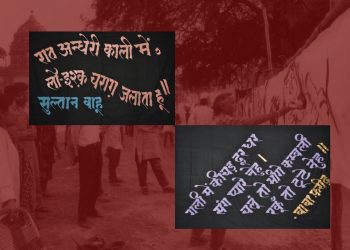The demolition of the Babri Masjid was fundamentally transformative to India’s secular fabric. In 1993, as a fitting collective response to the demolition of Babri Masjid, contesting the idea that Ayodhya was a Hindu site that needed to be reclaimed by the Hindu majoritarian community, instead foregrounding the city’s rich, diverse, complex and lesser known history in architecture, early art, and literature, Sahmat set up the exhibition Hum Sab Ayodhya.
The exhibition showcased paintings, mythological stories and their many versions. Two panels on multiple versions of the Rama myth (the Ram Katha) became the focus of an attack on the exhibition. The Bharatiya Janata Party (BJP) and right-wing groups campaigned to have the panels banned and the Delhi police seized them. Even though the exhibition has faced several attacks and vandalism, it continues to be shown and travel widely within India and outside, since the Ayodhya issue remains critical to the definition of India as a secular republic after nearly three decades since the demolition.




